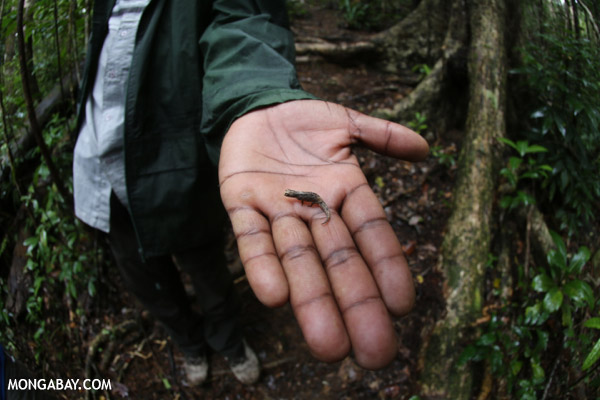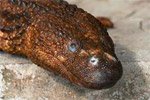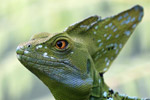World’s chameleons facing potential extinction crisis

The lesser chameleon (Furcifer minor) is listed as Endangered. This species is only found in Madagascar. Photo by: Christopher V. Anderson.
Chameleons are an unmistakable family of wonderfully bizarre reptiles. They sport long, shooting tongues; oddly-shaped horns or crests; and a prehensile tail like a monkey’s. But, of course, chameleons are most known for their astonishing ability to change the color of their skin. Over millions of years, these Old World reptiles have used this evolutionary trait for an astonishing variety of reasons, including camouflage, complex communication, and to keep warm in the cold or vice versa. But a new update of the IUCN Red List finds that this unique group of lizards is facing a crisis that could send dozens, if not more, chameleons to extinction.
Chameleon expert, Christopher V. Anderson, with Brown University said that while the chameleon’s distinct features attracted him to the family, he was also drawn in by their stunning diversity.
“Chameleons span an approximate 20-fold range in adult total length and a 2000-fold range in body mass,” he told mongabay.com. “They include the shortest lived tetrapod [four-legged] species, as well as species that are known to live over 20 years. They exhibit an extensive range of ornamentations, including horns of different shape, size, number and arrangement, sail on their tail, and spiny crests and projections from various parts of the body. They also live over incredible ranges of habitats, and demonstrate an abundance of variation in their behavior and ecology. I find that diversity particularly intriguing.”
The new update on chameleons, conducted by the SSC Chameleon Specialist Group (CSG), finds that over a third of the world’s chameleon species are threatened with extinction. In this survey researchers have assessed almost all of the world’s chameleons: 184 of the world’s 200 chameleon species—or 92 percent of known species. Of these, nine species have been listed as Critically Endangered, 37 as Endangered, and 20 as Vulnerable, making a grand total of 66 threatened chameleons. If the Near Threatened category is taken into account—adding another 35 species—the percentage of chameleons in danger jumps to 55 percent.
Not only are the numbers for chameleons bleak, but they are even bleaker than those for the whole reptile family. In all, 36 percent of chameleons are currently threatened with extinction when looking at those for which there is sufficient data, but the percentage for reptiles as a whole is 19 percent. Although it must also be noted that less than half of the world’s reptiles have been assessed by the IUCN.

The West Usambara blade-horned chameleon (Kinyongia multituberculata) from Tanzania is listed as Endangered. Photo by: Christopher V. Anderson.
Anderson, who is also a member of the CSG, says that chameleons are so much more threatened than reptiles in general, because so many chameleon species are “range-restricted,” which means that “these species are endemic to small geographic areas, often a particular habitat on a single mountain.”
He added that “when species are range-restricted, their risk of extinction is heightened in the face of other threats. Many of these isolated habitats are under significant pressure from anthropogenic [human] activities, which results in a large number of chameleon species being highly threatened.”
Not surprisingly, then, Anderson says the biggest threat facing the chameleon family today is habitat degradation.
“This degradation is largely at the hands of agriculture and the exploitation of biological resources, such as timber harvesting,” he told mongabay.com. “Additional threats, such as climate change and illegal or unsustainable collection for the pet trade, are also a potential threat for some species.”
Another reason why chameleons face such high threats is that nearly half of all species are found in only one country: Madagascar. This insanely-biodiverse island nation houses 85 species of chameleon, all of them found no-where else. Madagascar’s remarkable chameleon’s include the world’s smallest: the micro leaf chameleon (Brookesia micra), which is listed as Near Threatened. But Madagascar has faced large-scale forest loss due to slash-and-burn farming, known locally as “tavy,” illegal logging, and agricultural fires. This has put many of the island’s unique species, including lemurs, on the endangered list. Currently, around 29 percent of Madagascar is covered in forest according to the Global Forest Watch, but less than a quarter of surviving forest is primary.

A juvenile Brookesia micra on a match head. This recently discovered chameleon (2012) is the smallest in the world. Photo by: Glaw et al/Creative Commons 2.5.
“Of [the Madagascar chameleons], 52 percent are threatened and 70 percent are considered threatened or near threatened! This includes five species assessed as Critically Endangered and 23 species assessed as Endangered!” exclaimed Anderson.
Given that the largest threat to chameleons is habitat degradation, Anderson says the best way to save them is better protection—and management—of their habitats.
“The protection of [chameleon] habitats is the primary conservation action needed to ensure their long term survival,” he explained. “While many of these species already exist in protected areas, these reserves and parks are often still subject to degradation and themselves need to be managed to limit the encroachment of human activities that may threaten the chameleons and other inhabitants.”
The CSG is not sitting on their haunches, but are using this new update to raise funds to look for what they deem the rarest chameleon on Earth: Chapman’s pygmy chameleon (Rhampholeon chapmanorum). Not seen in 15 years, the Critically Endangered species may even be extinct as its forest home in Malawi has been whittled down to two forest fragments, equaling just 0.6 square kilometers in total. Using the crowdsourcing site Rockethub, scientists are hoping to raise enough funds for an expedition to the Malawi Hills in Malawi to conduct a thorough search for Chapman’s pygmy chameleon.
For the scores of other threatened chameleons, hopefully their situation won’t have to deteriorate so far before conservation groups take greater note.

A female Chapman’s pygmy chameleon (Rhampholeon chapmanorum). Last seen in 1998, researchers hope the species isn’t extinct but only a survey in its forests will tell. Photo by: Colin Tilbury.
-spinosus-231-copy.600.jpg)
The Usambara spiny pygmy chameleon (Rhampholeon spinosus) from Tanzania is listed as Endangered. Photo by: Christopher V. Anderson.

The Usambara flap-nosed chameleon (Kinyongia tenuis), also from Tanzania, is considered Endangered. Photo by: Christopher V. Anderson.
-acuminatus-029-copy.600.jpg)
The Nguru spiny pygmy chameleon (Rhampholeon acuminatus) from Tanzania is Critically Endangered . Photo by: Christopher V. Anderson.

Peyrieras’ pygmy chameleon (Brookesia peyrierasi) from Madagascar is considered Endangered. Photo by: Rhett A. Butler.
Related articles
New gecko described in Madagascar
(11/16/2014) Researchers have described a previously undocumented species of gecko in Madagascar.
Bizarre lizard newest victim of reptile pet trade

(09/15/2014) If you’ve never heard of the earless monitor lizard, you’re not alone: this cryptic lizard has long-escaped the attention of the larger public. But over the past couple years its bizarre appearance has been splashed across social media sites for reptile collectors. While this decidedly-quirky attention may seem benign, it could actually threaten the species’ existence.
Google Earth spurs discovery of a ‘new’ chameleon species

(08/17/2014) Google Earth has spurred the discovery of another new species. In this case, the creature is a pygmy chameleon, one of four previously unknown Rhampholeon chameleon species described from the remote ‘sky islands’ in Mozambique. The Mount Mabu pygmy chameleon was discovered after Google Earth images of a tract of forest led Julian Bayliss to launch a scientific expedition to the region.
The threat of traditional medicine: China’s boom may mean doom for turtles

(08/08/2014) Despite a lack of scientific evidence demonstrating a causative link between turtle consumption and medicinal benefits, many people in China believe they can be used to cure disease and maintain health. Because of this, turtles have been highly sought after for more than 3,000 years. However, in recent years, China’s economy has changed in a way that has become increasingly threatening to the country’s wild turtle populations.
Scientists catalog the world’s 10,000th reptile

(08/04/2014) As of this year, scientists have named and described over 10,000 reptiles, marking a new milestone in cataloging one of the most diverse vertebrate groups. Last week, the Reptile Database, an online catalog of all the world’s living reptiles, announced it had passed 10,000 species.
No longer ‘deaf as a stump’: researchers find turtles chirp, click, meow, cluck

(07/25/2014) Turtles comprise one of the oldest living groups of reptiles, with hundreds of species found throughout the world. Many have been well-researched, and scientists know very specific things about their various evolutionary histories, metabolic rates, and the ways in which their sexes are determined. But there was one very obvious thing that has been largely left unknown by science until very recently. Turtles can make sounds.
Please, don’t hate us: celebrating World Snake Day!

(07/16/2014) Okay, so some snakes are so venomous they can kill you in 30 minutes (the inland taipan). And, yes, the fact that they don’t have legs is a little creepy to many people. And, admittedly, some scientists have even suggested that humans may have an inborn genetic terror of snakes.